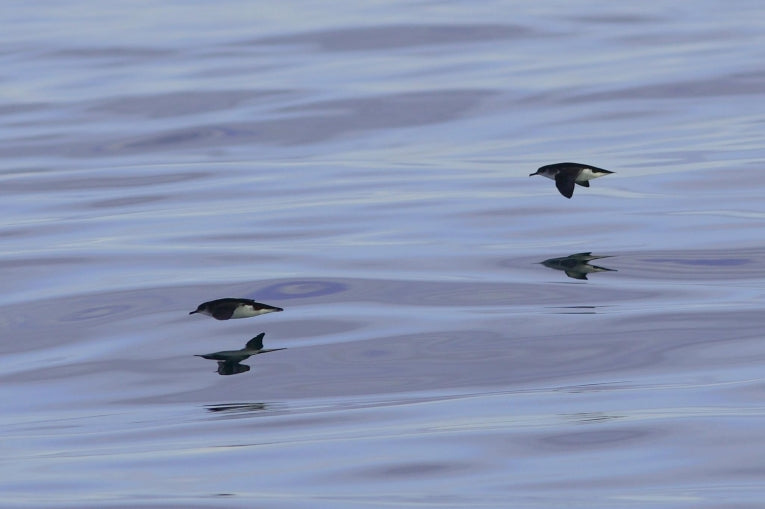The Manx shearwater (misleadingly named (Puffinus puffinus) is a rare sight in Europe partly because of its nocturnal habits. Competition over millions of years has forced it into burrows on small islands where predation is reduced.
The remarkable nature of its wave-clipping flight is surpassed by its record longevity. A 55 year-old was recorded from the site below (Copeland Island.) It must have travelled 1 million km in its life as the annual migration to South America adds to your air miles!
Several island species and sub-species have become extinct, but the Manx version, having been wiped out at one point, is now being re-established. Manx refers to the island in the northern part of the Irish Sea known as the Isle of Man! Ben Dean et al of Oxford University, Microsoft Research Ltd and the British Antarctic survey have used the latest high-tech miniature data-loggers from British Antarctic Survey, of all people, to assess the at-sea activity of this elusive sea-bird. Future bio-logging research will certainly benefit as animal "decision-making" and response to prey can be investigated remotely using similar equipment.

Density distributions of each activity for birds from (a) Copeland and (b) Skomer during the 2009 chick-rearing period: (i) foraging (red), (ii) direct flight (green), (iii) sitting (blue). Densities are shaded from the lightest (95% occupancy) to the darkest (10% occupancy). The locations of Copeland and Skomer are on the NE Irish coast on the top maps and the far SW of Wales on the bottom maps. [SCALE SHOWS 100/200km.]; Credit: © Journal of the Royal Society Interface
Future bio-logging research will certainly benefit as animal "decision-making" and response to prey can be investigated remotely using similar equipment. Pelagic animals are elusive and this system of relatively inexpensive miniature telemetry detects different modes of movement using a system called hidden Markov models (HMM.) Assuming an unobserved set of behaviours that follow on from each other, this system was able to infer resting, diving and flying modes from speed.
Laying a single egg, parents fly long foraging stints of around 6 days during incubation. When the chick hatches, shorter trips are made with night returns to avoid predators such as sea. Two independent loggers simultaneously sorted out the at-sea activity into discrete behavioural states for a period of 3 years. Skomer Island in Wales and Lighthouse Island at Copeland Island, Northern Ireland were the colonies used. Both sites used inspection hatches above the burrows, from which 117 adults were weighed and the two devices, with a total mass of 18g, deployed.
315 successful sorties were made into the Irish and Celtic Seas and four very long trips into the Atlantic excluded from results. Hatching success varied from 77-7% to 82.4% while 100% of the fledglings from Skomer.
Highly detailed data from GPS, sea-water immersion loggers and TDRs gave a lot of information on individual birds. No detectable difference was noted in control tests to see if the tiny detectors had affected the shearwaters in any way, although it's possible trip duration was affected. It was possible to detect slight delays for Skomer birds. Overlap from the two colonies agrees with the norm for aggregation of seabirds at frontal systems (eg. SW of the Isle of Man.) Plankton growth and fish densities are high here. Summer fronts become established in the Celtic sea, close to the nesting sites during the chick-rearing period. Copeland Island breeders seem to benefit from reduced travel if the figures for foraging time and direct flight are studied. These birds had slightly higher mass during incubation too.
At Skomer the birds worked harder, showing up the difference in foraging trip behaviour. The way in which any animal responds to prey and its distribution shows us its decision-making capabilities. Now such research can be applied to the placing of wind turbines, various fisheries research and surface pollution problems. These micro-loggers will be used again, it's certain, but it will intrigue us as to how they can be employed for many different beasts.
The full paper, Behavioural mapping of a pelagic seabird: combining multiple sensors and a hidden Markov model reveals the distribution of at-sea behaviour, has been published today in the Journal of the Royal Society Interface.










